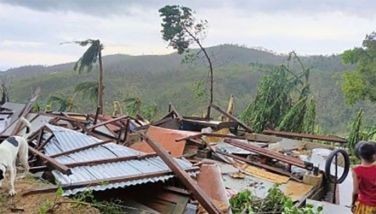WWF: Bataan coral reefs in 'dismal state'
MANILA, Philippines - Conservation groups yesterday urged investments to protect the remaining coastal resources of Bataan, as they lamented the “dismal state” of the coral reefs in the province due to blast and cyanide fishing.
During a joint ecological immersion to survey the coastal resources of Morong town last month, the World Wide Fund for Nature-Philippines (WWF-Philippines) and Manila Ocean Park (MOP) noted the state of the coral reef fronting the mothballed Bataan Nuclear Power Plant.
Morong is a known nesting site for endangered olive-ridley sea turtles (Lepidochelys olivacea), the smallest of the world’s seven sea turtle species and globally classified by the International Union for the Conservation of Nature (IUCN) as vulnerable.
Allied organizations such as the Bantay Pawikan Project have been working to safeguard sea turtle hatchlings since 1999.
According to WWF-Philippines, the outskirts of the BNPP were once fronted by a healthy coral reef. Today, however, the area has become “a barren graveyard of broken algae-encrusted coral rubble,” it said.
“The twin banes of intensifying tropical storms plus unchecked blast fishing may be blamed for the damage. Locals also speak of a massive storm, which made landfall approximately 40 years back,” said Gregg Yan, information, education and communications officer of WWF-Philippines.
Although the state of the surveyed coral reef fronting the BNPP was deemed bleak, both the WWF and MOP nevertheless recognized the “prime opportunity” to safeguard what is left of the once-magnificent reefs, seagrass beds, and mangroves of the Bataan coastline.
All that is needed, WWF-Philippines pointed out, is “farsighted funder” to make sure that the remaining coastal resources of Bataan are conserved.
Taking cue from proven coastal management efforts in the past, WWF’s Ruel Bate, who formerly oversaw a coastal resource management initiative for Morong, said a period of respite could drastically improve the productivity of a coastal area.
“Though the state of the coral reef we surveyed was dismal, there is definitely a strong opportunity here: an opportunity to invest in the protection of Bataan’s coastal resources,” added Jappy Lim, program facilitator of the MOP.
Bate cited that among the strong coastal management efforts that have shown impressive results was the one made in the world-renowned Tubbataha Reefs off Palawan from 2004 to 2005.
He said the Tubbataha Reefs doubled its yearly fish biomass from 166 to 318 metric tons per square kilometer due to increased protection and efficient management efforts.
Now the area, he said, boasts of a yield seven times more productive than a typical healthy coral reef.
“Aggressive coastal resource management efforts always produce favorable results for both local communities and tourists,” Bate said.
“We have a window to protect what reefs remain, as some of Morong’s coasts still have excellent coral cover,” he added.
As part of the ecological immersion in Morong, WWF-Philippines and MOP also partnered in planting mangroves, assessing marine habitats and polishing field skills to become better advocates for coastal conservation.
The groups planted mangrove seedlings by a brackish-water stream and surveyed Morong’s seagrass beds, a vital nursery for juvenile fish and invertebrates, instrumental in binding sediments and producing nutrients.
- Latest
- Trending






























